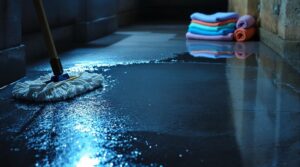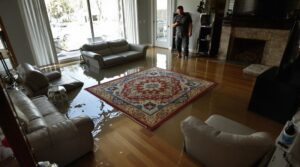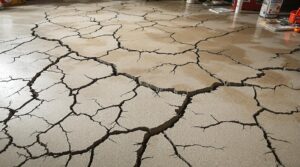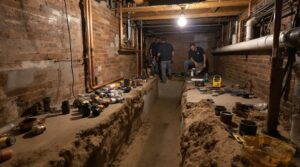During a hurricane-induced house flood, immediate evacuation to higher ground or upper floors is essential for safety. Residents must shut off electrical power at the main breaker and gather emergency supplies including water, food, and first aid materials. Battery-powered lights should be used instead of candles. Documentation of damage through photos and detailed notes is vital for insurance claims. Professional assistance from public adjusters can greatly improve claim outcomes and recovery efforts.
Key Takeaways
- Evacuate immediately to higher ground or upper floors of your home and monitor emergency broadcasts for updates.
- Turn off electrical power at the main circuit breaker and use battery-powered lights instead of candles.
- Gather essential supplies including drinking water, non-perishable food, and first aid kits for immediate safety.
- Document all flood damage with clear photos and measurements before removing anything for insurance claims.
- Contact your insurance provider and consider hiring a public adjuster to maximize your claim settlement.
Immediate Safety Steps During Hurricane Flooding
When floodwaters begin entering a home during a hurricane, residents must take immediate action to protect themselves and their families. The first priority is evacuating to higher ground, either by moving to upper floors of the home or leaving the property entirely if conditions permit safe passage.
Before water levels rise substantially, residents should immediately shut off electrical power at the main circuit breaker to prevent potential electrocution hazards and reduce damage to the home's electrical system.
Essential supplies, including first aid kits, drinking water, and non-perishable food, should be quickly gathered and relocated to an elevated area.
For illumination, only battery-powered light sources should be used, as candles pose fire risks in potentially gas-compromised environments.
Throughout the emergency, maintaining contact with current weather updates and local emergency broadcasts is vital for situational awareness.
After ensuring personal safety, residents should document the damage for insurance purposes using photographs when it becomes safe to do so.
Essential Emergency Contacts and Communications
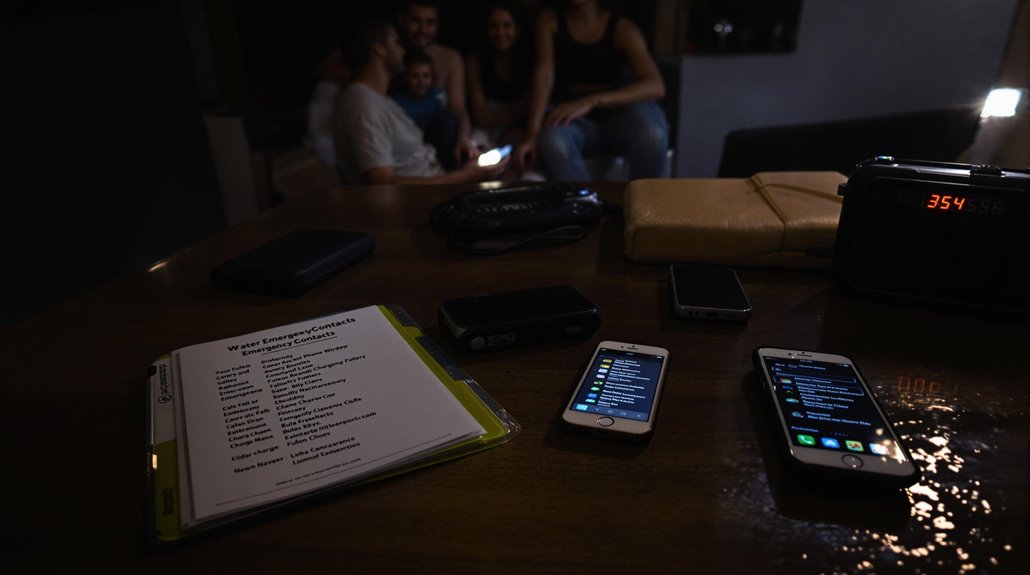
Maintaining reliable communication channels during a hurricane flood emergency can mean the difference between safety and tragedy. Residents should create a thorough list of essential emergency contacts before disaster strikes, including local emergency services, insurance providers, and trusted family members or friends who can assist during the crisis.
A dual approach to storing contact information is essential: digital storage in mobile phones should be backed up with printed copies kept in emergency kits. This redundancy guarantees access to critical numbers even if cellular networks fail.
Additionally, homeowners should establish connections with FEMA and the Red Cross, as these organizations provide important disaster response support.
To maintain emergency communications capabilities throughout the flooding event, individuals should keep portable battery banks or solar chargers ready.
Social media platforms and messaging applications can serve as alternative communication methods when traditional phone systems become overwhelmed, enabling affected residents to update loved ones about their safety status.
Documenting Flood Damage for Insurance Claims
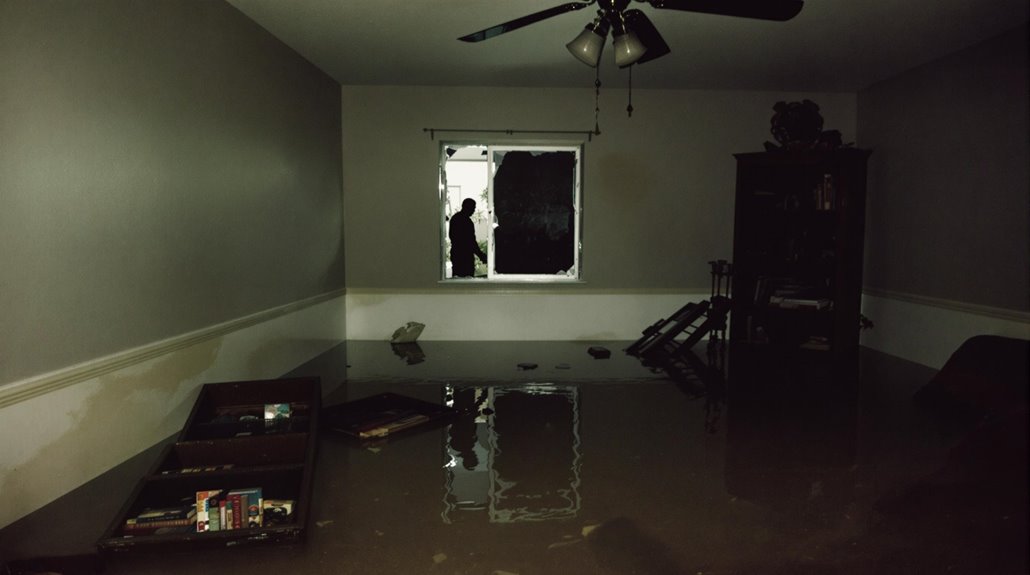
Proper documentation of flood damage stands as an essential first step in securing fair compensation from insurance providers after a hurricane. Homeowners must capture extensive photographic evidence of all affected areas, including water levels and damaged belongings, before initiating cleanup efforts. When documenting flood damage, precise measurements and detailed descriptions of damaged items are vital for insurance claims.
| Documentation Element | Required Action |
|---|---|
| Photographs | Capture clear images of all damage and water levels |
| Measurements | Record flood height on walls and size of damaged items |
| Item Details | List make, model, age of damaged belongings |
| Communications | Log all interactions with insurance adjuster |
Insurance adjusters rely on thorough documentation to process claims effectively. Homeowners should maintain detailed records of all communications with their flood insurance provider, including dates and discussion points. It's essential to avoid removing or cleaning damaged materials until proper documentation is complete, as premature cleanup could compromise the insurance claim process.
Water Removal and Initial Clean-Up Procedures
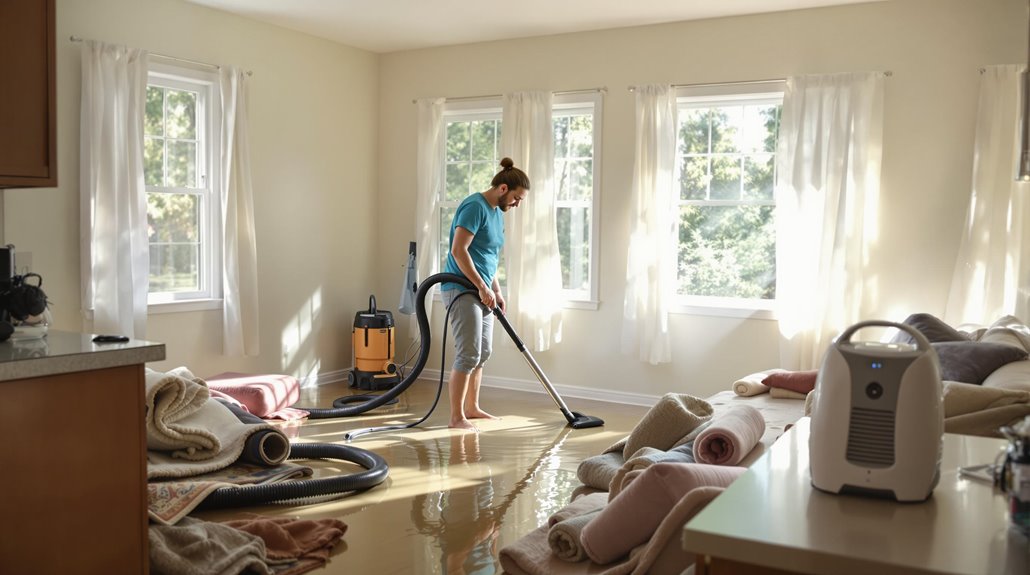
Swift action in water removal marks the vital first phase of post-hurricane cleanup operations.
Before initiating the clean-up process, homeowners must guarantee all electrical systems are completely powered down to prevent shock hazards from standing water and moisture exposure.
Once safety measures are confirmed, water removal can begin using sump pumps or wet/dry vacuums to efficiently extract standing water from the premises.
The next vital step involves removing water-damaged materials, including carpeting, furniture, and saturated insulation, which can become breeding grounds for harmful bacteria and mold if left in place.
To expedite drying, homeowners should position dehumidifiers strategically throughout the space while opening windows to promote air circulation.
All surfaces that encountered floodwater require thorough disinfection to eliminate potential health hazards.
These initial cleanup steps not only prevent further structural damage but also provide essential documentation for homeowners insurance claims while creating safer conditions for subsequent restoration work.
Working With Professionals for Recovery
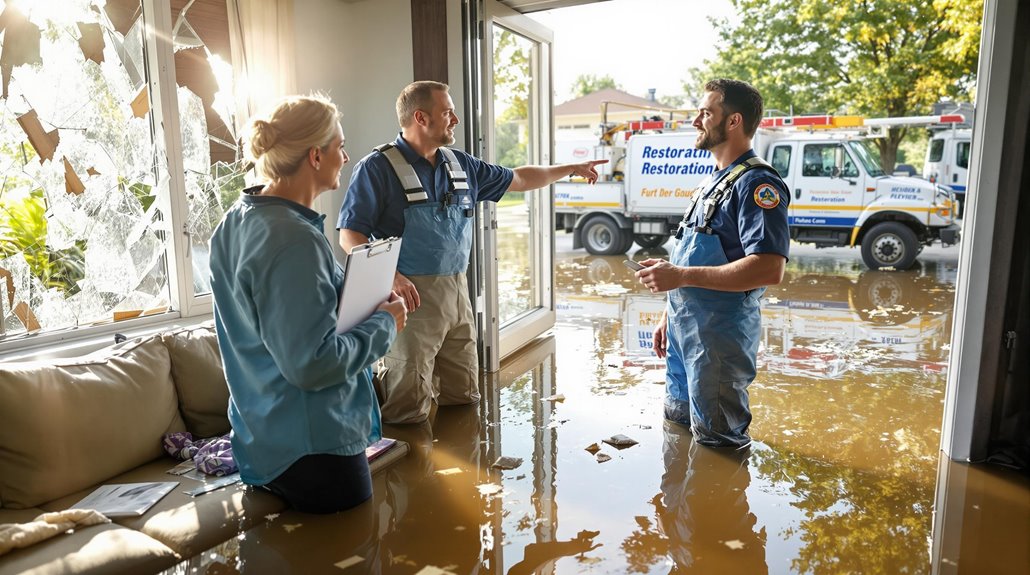
Professional assistance proves crucial for extensive flood recovery, as experienced contractors possess the expertise and resources to handle complex restoration challenges. When looking to work with professionals, homeowners should begin by obtaining multiple quotes from contractors who specialize in flood damage restoration.
| Recovery Steps | Key Requirements |
|---|---|
| Initial Search | Contact your local restoration companies |
| Verification | Confirm contractors are licensed and insured |
| Documentation | Get all estimates in writing |
| Claims Support | Select contractors experienced with insurance claims |
| Professional Help | Consider hiring a public adjuster |
Before committing to any restoration work, homeowners must verify that contractors are licensed and insured, protecting themselves from potential liability issues. Working with professionals who have experience handling insurance claims can considerably streamline the recovery process. Maintaining detailed documentation of all agreements and estimates provides essential protection for both parties. For complex cases, hiring a public adjuster can help navigate challenging insurance claims and guarantee fair compensation for damages.
Prevention Strategies for Future Hurricane Floods
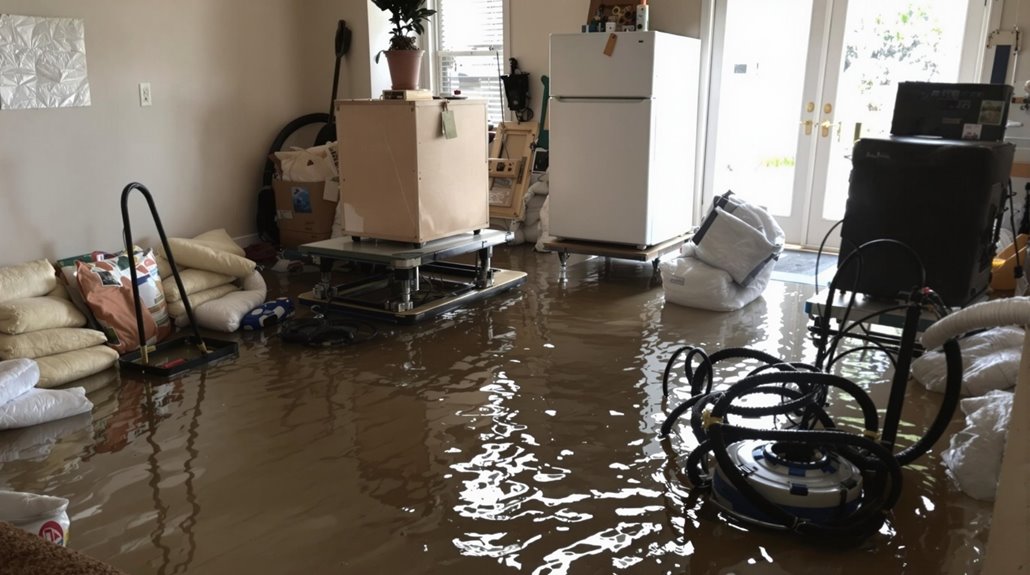
With flood recovery efforts complete, homeowners can take proactive measures to protect their properties against future hurricane flooding. Implementing strategic precautions can greatly reduce potential damage and financial impact during severe weather events.
Essential preventive measures include:
- Elevating critical electrical systems and appliances at least 12 inches above ground level
- Installing backup-powered sump pumps to manage water accumulation
- Constructing waterproof barriers and levees around the property
- Maintaining clean gutters and properly functioning downspouts
- Securing thorough flood insurance coverage through NFIP
Homeowners should note that flood damage can affect properties even outside designated high-risk zones, making insurance policy coverage essential regardless of location.
Regular maintenance of drainage systems combined with structural modifications provides multi-layered protection against water intrusion.
These preventive strategies require initial investment but offer long-term protection for both the property and its contents during future hurricane events.
The Benefits Of Consulting A Public Adjuster
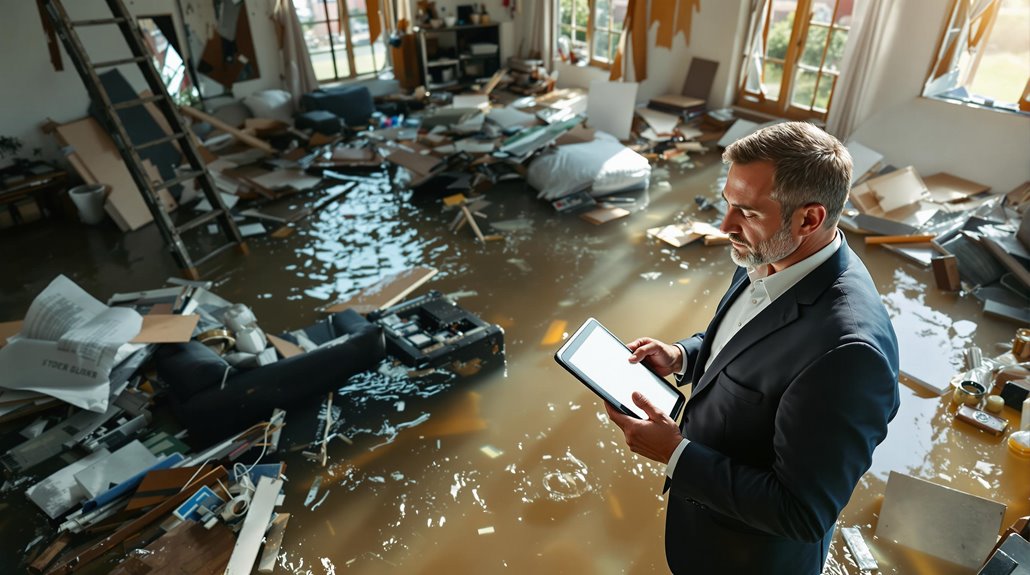
Following a hurricane flood, consulting a licensed public adjuster can provide critical expertise in maneuvering complex insurance claims and documenting property damage.
Public adjusters conduct objective assessments and handle the entire claims process, reducing stress while ensuring thorough documentation of all damages.
Studies indicate that policyholders who engage public adjusters often receive notably higher settlements, with payouts up to 800% more than those handling claims independently.
Expertise In Insurance Claims
Insurance claims following a hurricane-related flood can be intimidating, which is why many homeowners turn to public adjusters for expert guidance.
These professionals possess extensive knowledge of insurance policies and can greatly improve the claims process, often securing 20-50% higher settlements for their clients.
Key advantages of working with a public adjuster include:
- Professional documentation of damage with photos and detailed assessments
- Expert interpretation of homeowners or renters insurance policies
- Maximization of settlement amounts through thorough claim preparation
- Clear distinction between flood and standard insurance coverage
- Strategic advocacy throughout the claims process
While public adjusters typically charge 5-15% of the settlement amount, their expertise in helping file a claim often results in considerably higher compensation that outweighs their fees.
This makes them a valuable resource for hurricane-affected homeowners.
Objective Damage Assessment
A thorough damage assessment conducted by a public adjuster can greatly impact the outcome of flood insurance claims after a hurricane. When homeowners contact their insurance company, having an objective assessment from a qualified professional guarantees all water damage is properly documented and valued.
| Assessment Aspect | Benefits | Key Actions |
|---|---|---|
| Documentation | Complete evidence collection | Photograph all damage |
| Valuation | Accurate cost estimation | List affected items |
| Professional Review | Expert analysis | Take precautions while inspecting |
| Claims Process | Higher settlement potential | Document repair requirements |
With the help of a professional adjuster, property owners receive an unbiased evaluation that typically results in 20-30% higher settlements compared to self-managed claims. This objective assessment approach helps streamline negotiations with insurance providers while guaranteeing all damage is properly identified and documented according to industry standards.
Streamlined Claim Process
Working with a public adjuster provides homeowners with significant advantages when managing flood insurance claims after a hurricane.
These professionals streamline the claims process while securing higher insurance settlements for property owners facing flood damage.
Key benefits of hiring a public adjuster include:
- Expertise in maneuvering complex insurance policies and negotiating settlements
- Thorough documentation and accurate assessment of flood damage
- Contingency-based payment structure, requiring no upfront costs
- Settlements averaging 20-50% higher than self-managed claims
- Professional advocacy that reduces stress during recovery
When home floods occur, public adjusters handle the intricate details of claims documentation, allowing homeowners to focus on immediate recovery needs.
Their specialized knowledge guarantees proper valuation of damages and maximizes the potential settlement, making them valuable allies during post-hurricane insurance negotiations.
Higher Claim Payouts & Settlements
Documented evidence consistently shows that homeowners who engage public adjusters receive substantially higher insurance settlements for flood-related claims.
Statistical data indicates settlements can be 20-40% higher when compared to claims handled without professional assistance.
Public adjusters leverage their industry expertise to negotiate settlements effectively, ensuring all damage to your home is properly documented and valued.
These professionals understand common undervaluation strategies used by insurance companies and can counter them with detailed evidence of losses.
Their thorough knowledge of insurance claims procedures and terminology allows them to maximize claim payouts while protecting homeowners' interests throughout the process.
About The Public Claims Adjusters Network (PCAN)
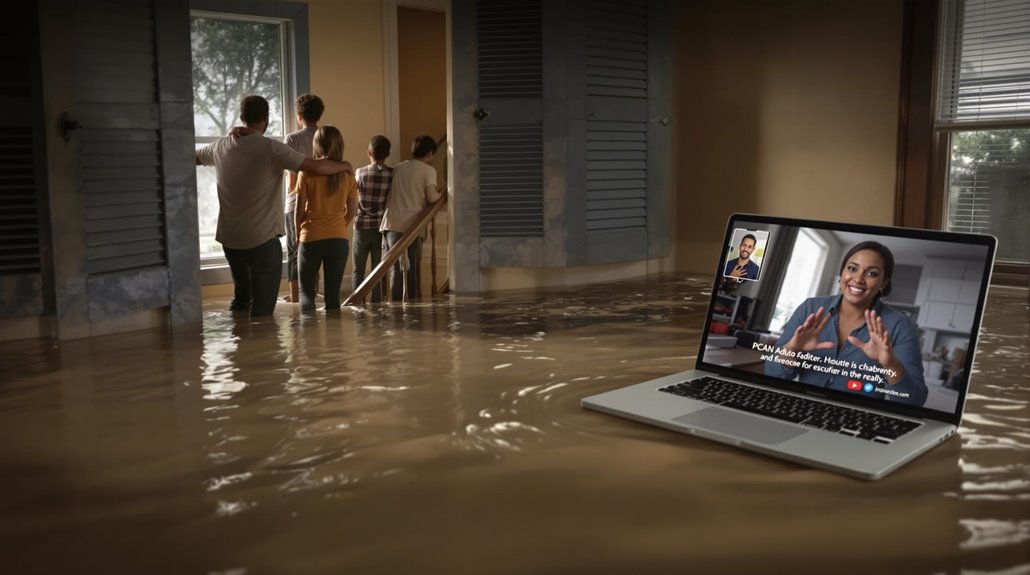
The Public Claims Adjusters Network (PCAN) stands as a nationwide organization of thoroughly vetted, state-licensed public adjusters who help property owners navigate insurance claims after disasters.
Operating across 40+ states, PCAN members specialize in both residential and commercial property damage claims, offering expertise in over 30 different claim types.
Key aspects of PCAN include:
- Rigorous vetting and intensive application process for all member adjusters
- Mandatory annual audits of licenses and complaint records
- Coverage of diverse property damage scenarios, including flood waters
- Direct connections between policyholders and expert adjusters
- Strict adherence to professional ethics and industry standards
PCAN serves as an essential resource for property owners seeking qualified representation during insurance claims.
The network maintains high professional standards through continuous monitoring of its members, ensuring policyholders receive expert assistance from adjusters who meet stringent quality and ethical requirements.
Frequently Asked Questions
What to Do if a House Floods During a Hurricane?
During flooding, residents should prioritize hurricane safety measures, maintain emergency kit essentials, document damages, contact insurance for claims processing, and implement post-flood recovery steps while following flood preparation protocols.
Will FEMA Pay for My Flooded House?
When floodwaters strike, FEMA assistance can be a lifeline. Homeowners must meet eligibility requirements, have flood insurance, and file claims within 60 days of disaster declaration to receive flooding resources and disaster relief.
When Should You Evacuate a Flooded House?
Immediate evacuation is necessary when authorities issue orders, floodwaters threaten safety, emergency contacts are unreachable, or risk assessment indicates danger. Follow established evacuation plans and safety measures without delay.
Can a House Be Saved After a Flood?
Even after a million gallons of water damage, houses can typically be saved through proper flood recovery procedures. Swift action, adequate insurance coverage, and professional restoration processes prevent permanent structural damage with appropriate prevention measures.
Final Thoughts
When faced with hurricane flooding, taking swift action and following proper procedures can make the difference between a manageable recovery and a prolonged nightmare. While homeowners may feel like they're drowning in paperwork and repairs, partnering with qualified professionals, including public adjusters, can help navigate the complex restoration process. By implementing preventive measures and maintaining proper documentation, property owners can weather future storms more effectively.
For homeowners dealing with property damage related to flooding or any other perils covered by their homeowners insurance policy, both insurance industry insiders and legal experts strongly advise consulting with a qualified state-licensed public adjuster. These professionals work exclusively for policyholders, not insurance companies, and serve as dedicated advocates throughout the claims process. Public adjusters are specially trained to identify hidden damages that homeowners might not know are covered under their policies, thoroughly document losses, and negotiate with insurance companies to ensure fair settlements. Their expertise typically results in maximized claim payouts, expedited processing, and reduced stress for property owners. Policyholders interested in discussing their property damage claims can request a no-obligation free consultation with a Public Claims Adjusters Network (PCAN) member through their contact page.
